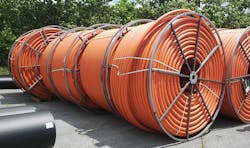We've entered the age of the MegaCampus. Data center projects exceeding 100 megawatts once seemed unthinkable, but have now become routine. But these campuses require an amount of land and power that simply isn't available in a growing number of markets. Where will these MegaCampuses be built?
That's today's topic as we conclude our Data Center Frontier Executive Roundtable for the first quarter of 2023. Our panelists include Flexential CEO Chris Downie, Nancy Novak of Compass Datacenters and Infrastructure Masons, Sabey Data Centers' Tim Mirick, and George Slessman, the CEO of DCX. The conversation is moderated by Rich Miller, the founder and editor of Data Center Frontier. Here’s today’s discussion:
Data Center Frontier: As campuses get larger and some primary markets experience constraints on land or power, what are the characteristics that will define growth markets in the next several years?
Chris Downie, Flexential: From Northern Virginia to Silicon Valley, space and power challenges are particularly acute in primary data center markets given available land, data center space and power are already in short supply. On top of this already crowded market, ongoing supply chain disruptions and geopolitical challenges are causing many high-tech companies to bring their research and development (R&D) and manufacturing operations back to the States, pushing tier 1 markets to their tipping point. The increased demand for data center space and power has caused a keen focus (and need) on tier 2 markets for future expansion plans, like Hillsboro, OR.
Hillsboro delivers a prime geographic gateway to cultivate business relationships with Asia Pacific counterparts, as well offering attractive business tax incentives, tax credits and abatement programs. Flexential is one of the first industry leaders to establish a presence in Hillsboro's fast-growing market and recently expanded its footprint with Hillsboro 4 in September 2022. As the long-standing home of the New Cross Pacific and Hawaiki subsea cables and offering access to three other subsea cables in the market, the Hillsboro 2 data center has established a reputation as the most connected data center in Oregon. In 2023 and beyond, we’ll see more companies shift their focus to tier 2 markets.
Nancy Novak, Infrastructure Masons: I think the answer to this question is straightforward. Future growth markets will be those with the available land, power and associated infrastructure capable of supporting tens of MW at the very least. As mentioned above, the current alignment of these requirements with available capabilities of some of our larger markets may result in multiple smaller markets that previously wouldn’t have been considered as desirable sites to become more attractive to a host of suitors.
As a result of this potential rise to prominence it would not be unexpected to see larger investments in infrastructure in these smaller communities to make them even more attractive for providers who can’t afford to wait (and these days who can?) on these same elements in larger locations.
Tim Mirick, Sabey Data Centers: The applications we support will dictate where the growth continues. For non-latency sensitive applications, growth will continue in locations with access to power, reasonable connectivity, business friendly environments and differentiated power pricing.
For customer services that require low latency, the industry will get creative and build capacity and network to support the demand where it needs to be. Based on those criteria, as the population increases, requirements change and some locations reach saturation, new hubs will be established and begin to grow.
George Slessman, DCX:: Data centers will continue to chase four things: low cost/available power, tax incentives, network access and accommodating regulation. Where these dimensions overlap, data centers will emerge.
NEXT: A full recap of our DCF Roundtable, with transcripts.
Keep pace with the fact-moving world of data centers and cloud computing by following us on Twitter and Facebook, connecting with DCF on LinkedIn, and signing up for our weekly newspaper using the form below:






